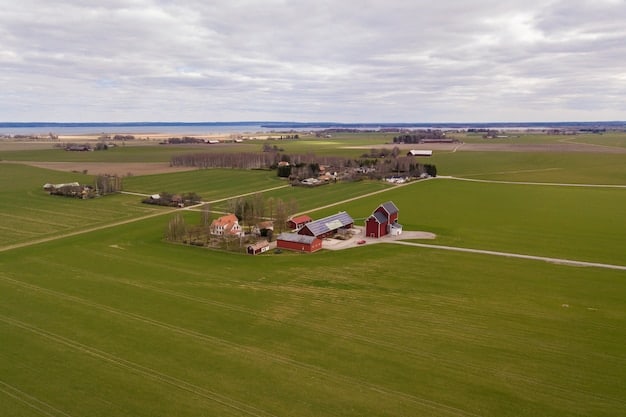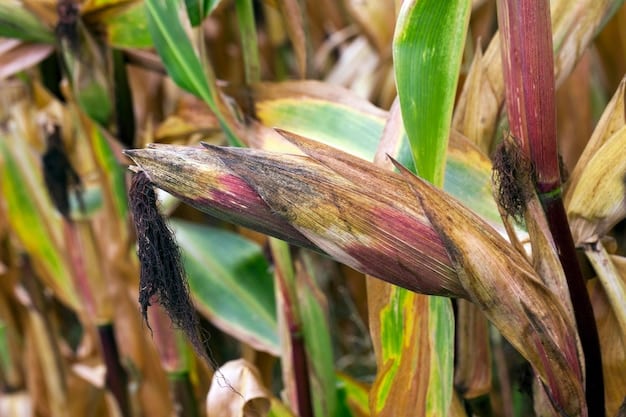Adapting to Climate Change: How US Farmers Can Protect Crop Yields

US farmers can adapt to the projected 10% decrease in crop yields due to climate change by implementing strategies like diversifying crops, adopting water-efficient irrigation, using climate-resilient seeds, improving soil health, and leveraging technology to optimize farming practices.
The looming threat of climate change poses a significant challenge to US agriculture, with projections indicating a potential 10% decrease in crop yields. Understanding How Can US Farmers Adapt to the Projected 10% Decrease in Crop Yields Due to Climate Change? is now more critical than ever, requiring proactive measures for a sustainable future.
How US Farmers Can Adapt to Climate Change: Protecting Crop Yields
Climate change is no longer a distant threat; it’s a present reality impacting agriculture across the United States. The anticipated decline in crop yields demands immediate and innovative adaptation strategies. This article explores the key measures US farmers can take to mitigate the effects of climate change and ensure food security for future generations.

Diversifying Crops and Farming Systems
One of the most effective ways to adapt to climate change is by diversifying crops and farming systems. Relying on a single crop can make farms vulnerable to climate-related disasters and changes in weather patterns. Diversification provides a buffer against these risks, ensuring a more stable income and food supply.
The Benefits of Crop Rotation
Crop rotation involves planting different crops in a sequence on the same land. This practice has several benefits, including improved soil health, reduced pest and disease pressure, and increased water infiltration. By rotating crops, farmers can create a more resilient and sustainable farming system.
Integrating Livestock
Integrating livestock into farming systems can also enhance resilience. Livestock can graze on cover crops, providing additional income and improving soil fertility. Manure from livestock can be used as a natural fertilizer, reducing the need for synthetic inputs.
- Implement crop rotation strategies to improve soil health and reduce pest pressure.
- Integrate livestock to utilize cover crops and provide natural fertilizer.
- Experiment with intercropping techniques to maximize land use and biodiversity.
- Explore agroforestry practices to enhance carbon sequestration.
Diversifying crops and farming systems is a crucial step towards building a more resilient agricultural sector. By adopting these strategies, US farmers can better withstand the impacts of climate change and ensure a sustainable future.
Adopting Water-Efficient Irrigation Techniques
Water scarcity is becoming an increasing concern due to climate change. In many regions of the US, farmers are facing reduced rainfall and increased drought frequency. Adopting water-efficient irrigation techniques is essential for conserving water resources and maintaining crop yields.
Drip Irrigation
Drip irrigation delivers water directly to the plant roots, minimizing water loss through evaporation and runoff. This method is highly efficient and can significantly reduce water consumption compared to traditional irrigation methods.
Smart Irrigation Systems
Smart irrigation systems use sensors and weather data to optimize water application. These systems can monitor soil moisture levels, rainfall, and temperature to determine the precise amount of water needed for each crop. This ensures that water is used efficiently and effectively.

Implementing water-efficient irrigation techniques helps farmers conserve water and reduce their environmental impact. It is a practical solution for mitigating the effects of drought and ensuring sustainable water use.
Utilizing Climate-Resilient Seed Varieties
Developing and utilizing climate-resilient seed varieties is crucial for adapting to changing environmental conditions. These varieties are bred to withstand extreme weather events, such as droughts, floods, and heat waves. Investing in climate-resilient seeds can help farmers maintain crop yields even in challenging conditions.
Drought-Tolerant Crops
Drought-tolerant crops are essential for regions facing water scarcity. These varieties can survive and produce yields with less water than traditional crops. Examples include certain types of corn, wheat, and sorghum.
Flood-Resistant Crops
Flood-resistant crops are vital for areas prone to flooding. These varieties can tolerate prolonged periods of waterlogging without significant yield loss. Examples include certain types of rice and soybeans.
- Invest in research and development of climate-resilient seed varieties.
- Promote the use of drought-tolerant and flood-resistant crops.
- Utilize gene editing technologies to enhance crop resilience.
- Support seed banks to preserve genetic diversity.
Utilizing climate-resilient seed varieties is a proactive approach to ensuring crop production in the face of climate change. These varieties provide farmers with a tool to adapt to changing environmental conditions and maintain food security.
Improving Soil Health
Healthy soil is more resilient to climate change impacts. Improving soil health can enhance water infiltration, reduce erosion, and increase carbon sequestration. Practices such as no-till farming, cover cropping, and composting can contribute to healthier soils.
No-Till Farming
No-till farming involves planting crops without disturbing the soil. This practice reduces erosion, conserves soil moisture, and improves soil structure. No-till farming can also increase carbon sequestration, helping to mitigate climate change.
Cover Cropping
Cover cropping involves planting crops specifically to protect and improve the soil. Cover crops can prevent erosion, suppress weeds, and add organic matter to the soil. They also help to retain nutrients and improve water infiltration.
Improving soil health is a fundamental aspect of climate change adaptation. By adopting sustainable soil management practices, farmers can enhance the resilience of their farms and contribute to a healthier environment.
Leveraging Technology for Climate Adaptation
Technology plays a crucial role in helping farmers adapt to climate change. Precision agriculture, remote sensing, and data analytics can provide farmers with valuable insights for optimizing their farming practices and mitigating climate-related risks.
Precision Agriculture
Precision agriculture involves using technology to tailor farming practices to specific areas within a field. This can include variable rate fertilization, precision irrigation, and targeted pest control. Precision agriculture can help farmers use resources more efficiently and reduce their environmental impact.
Remote Sensing
Remote sensing technologies, such as drones and satellites, can provide farmers with real-time data on crop health, soil moisture, and other important parameters. This information can be used to make informed decisions about irrigation, fertilization, and pest management.
- Invest in precision agriculture technologies to optimize resource use.
- Utilize remote sensing data for real-time monitoring of crop health.
- Employ data analytics to make informed decisions on farming practices.
- Promote the development and adoption of climate-smart technologies.
By leveraging technology, farmers can improve their ability to adapt to climate change and ensure sustainable crop production.
Government Policies and Support
Government policies and support are essential for enabling farmers to adapt to climate change. Policies that promote sustainable agriculture, provide financial incentives, and support research and development can help farmers implement climate-smart practices.
Incentive Programs
Incentive programs can encourage farmers to adopt sustainable practices such as no-till farming, cover cropping, and water-efficient irrigation. These programs can provide financial assistance, technical support, and educational resources.
Research and Development
Investing in research and development is crucial for developing climate-resilient seed varieties, improving soil health, and leveraging technology for climate adaptation. Government funding can support research institutions and universities in conducting research and developing innovative solutions.
Government policies and support are vital for creating an enabling environment for climate change adaptation in agriculture. By implementing effective policies and providing adequate support, governments can help farmers build more resilient and sustainable farming systems.
| Key Area | Brief Description |
|---|---|
| 🌱 Crop Diversification | Improves resilience by reducing reliance on single crops. |
| 💧 Water Efficiency | Conserves water through drip irrigation and smart systems. |
| 🌾 Resilient Seeds | Uses drought and flood-tolerant varieties to maintain yields. |
| 🚜 Soil Health | Enhances soil through no-till farming and cover cropping. |
Frequently Asked Questions
▼
The primary challenge is the projected 10% decrease in crop yields due to changing weather patterns, increased drought, and extreme weather events, threatening food security and farm viability.
▼
Crop diversification reduces reliance on single crops, providing a buffer against climate-related disasters and ensuring a more stable income and food supply for farmers.
▼
Farmers can use drip irrigation, which delivers water directly to plant roots, and smart irrigation systems that use sensors and weather data to optimize water application, minimizing waste.
▼
Healthy soil improves water infiltration, reduces erosion, increases carbon sequestration, and enhances overall farm resilience, making it a critical component of climate change adaptation.
▼
Government policies, incentive programs, and investments in research and development are essential for enabling farmers to adopt sustainable practices and build more resilient farming systems.
Conclusion
Adapting to climate change is crucial for US farmers to maintain crop yields and ensure food security. By diversifying crops, adopting water-efficient irrigation, utilizing climate-resilient seeds, improving soil health, leveraging technology, and receiving government support, farmers can effectively mitigate the impacts of climate change and build a more sustainable agricultural sector.





